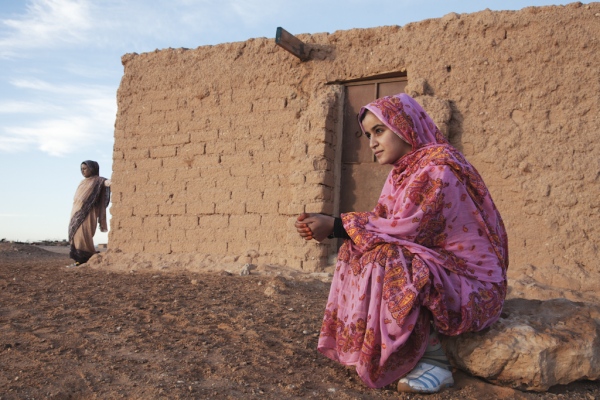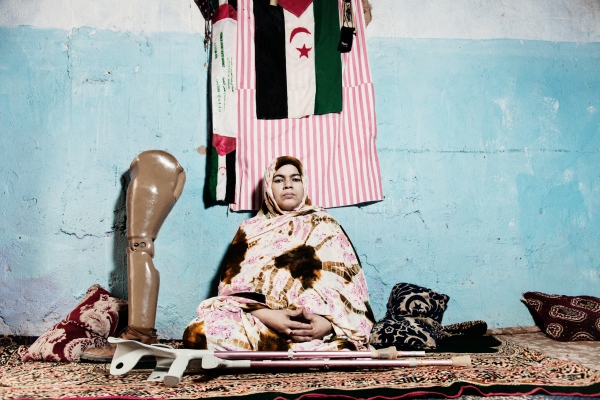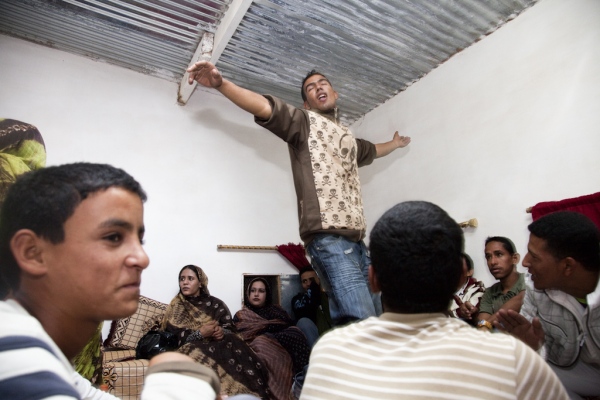
Waiting for freedom
The saharawis are made up of a number of nomadic Berber tribes that once moved freely and independently in the Western Sahara. They knew no borders and lived under the power of no government until 1886, the year they were colonized by Spain.
Although few people are aware of it, in the desert there is a 2700 km wall surrounded by seven million mines. It was built in 1975 during the “Green Marchâ€, which took place when Morocco invaded and militarily occupied the territory of the Western Sahara. Thousands of saharawis were forced to leave their land and seek refuge in the part of the desert to the southwest of Algeria. Those who couldn't escape had to continue living in the occupied areas under a repressive regime that violated their human rights.
Since then, the saharawis have lived in exile. For over 37 years they have been confined to the Algerian desert, an arid, landlocked region where living conditions are increasingly difficult. As a result of global warming, temperatures reach 50 degrees celsius in summer. Water is scarce, the last important rains having fallen a year-and-a-half ago.
Experiencing this in first person I understood that this population is reaching the limit of what it can bear, and that there will be a new war if the countries responsible for this situation, as well as the UN, don't decide to take action for these people.
The long wait is killing the identity and culture of a people with more than two thousand years of history who live only in the hope of one day being able to return to their land, free of all oppression by the Moroccan government.
Although few people are aware of it, in the desert there is a 2700 km wall surrounded by seven million mines. It was built in 1975 during the “Green Marchâ€, which took place when Morocco invaded and militarily occupied the territory of the Western Sahara. Thousands of saharawis were forced to leave their land and seek refuge in the part of the desert to the southwest of Algeria. Those who couldn't escape had to continue living in the occupied areas under a repressive regime that violated their human rights.
Since then, the saharawis have lived in exile. For over 37 years they have been confined to the Algerian desert, an arid, landlocked region where living conditions are increasingly difficult. As a result of global warming, temperatures reach 50 degrees celsius in summer. Water is scarce, the last important rains having fallen a year-and-a-half ago.
Experiencing this in first person I understood that this population is reaching the limit of what it can bear, and that there will be a new war if the countries responsible for this situation, as well as the UN, don't decide to take action for these people.
The long wait is killing the identity and culture of a people with more than two thousand years of history who live only in the hope of one day being able to return to their land, free of all oppression by the Moroccan government.

Landmine Victims
Sahrawi people are the tribe of the world that has been exposed to the longest period of forced exile. For 31 years, they have been cut off from their homeland and subject to the extreme conditions of a very arid desert that doesn’t offer any sustainable way of living. Given that their geopolitical situation doesn't allow them to develop economically, their survival depends almost entirely on international help. They are physically isolated by a wall of more than 7 million mines. These mines were all buried in most parts of the territory at the beginning of the war by Morocco, in order to stop the Polisario Front. There is no need to say that the mines also considerably slow down the emergence of any economical progress given the high cost incurred in the attempt to neutralize mines and the medical care of those wounded.
One of the main problems that international help faces is the increasing number of daily victims while medical care structures like hospitals lack the means to help people needing medical attention. Most human resources available come from people donating their time. This paired up with the lack of interest, the lack of communication and the seemingly non-existent presence of the international community, renders this situation completely unacceptable.
These images were captured a few months ago in a hospital for people wounded by the war and the mines while in camps for Sahrawi refugees. They denounce the situation that too many people have to face when they unluckily step onto one of these explosive artifacts. People that, from one day to the next, are suddenly dismembered and are confined to a wheelchair or a bed for the rest of their days.
One of the main problems that international help faces is the increasing number of daily victims while medical care structures like hospitals lack the means to help people needing medical attention. Most human resources available come from people donating their time. This paired up with the lack of interest, the lack of communication and the seemingly non-existent presence of the international community, renders this situation completely unacceptable.
These images were captured a few months ago in a hospital for people wounded by the war and the mines while in camps for Sahrawi refugees. They denounce the situation that too many people have to face when they unluckily step onto one of these explosive artifacts. People that, from one day to the next, are suddenly dismembered and are confined to a wheelchair or a bed for the rest of their days.

Wedding in exile
In 2010, I received a phone call from Abdelai (1984 ), one of the saharawi I met during my first experience in the Algerian desert. He wanted to marry Bakina (1986) on February 4th 2011 and I was invited to their wedding. There was no missing a traditional muslim wedding - a once in a lifetime occasion.
In respect with muslim tradition, I was not allowed, as a man, to stay with Bakina and her friends until the second day. Therefore I have essentially experienced and photographed Abdelai’s ceremony.
On the first day, the groom celebrated with his friends but, as tradition, he was not allowed to speak to them.
During the second day, they celebrated the official ceremony of the wedding. Abdelai discovered Bakina’s face, previously hidden under a white veil, and took her hand.
On the third day, all the guests ate a lunch made of camel meat. Then, traditional music and dances accompanied the last moments of the celebration.
Even if the ceremony was great, the overall feeling of happiness was punctuated by brief moments of silence. They seemed to be due to the monotony of everyday life in one of the most inhospitable landscape on Earth.
In respect with muslim tradition, I was not allowed, as a man, to stay with Bakina and her friends until the second day. Therefore I have essentially experienced and photographed Abdelai’s ceremony.
On the first day, the groom celebrated with his friends but, as tradition, he was not allowed to speak to them.
During the second day, they celebrated the official ceremony of the wedding. Abdelai discovered Bakina’s face, previously hidden under a white veil, and took her hand.
On the third day, all the guests ate a lunch made of camel meat. Then, traditional music and dances accompanied the last moments of the celebration.
Even if the ceremony was great, the overall feeling of happiness was punctuated by brief moments of silence. They seemed to be due to the monotony of everyday life in one of the most inhospitable landscape on Earth.
